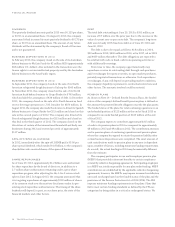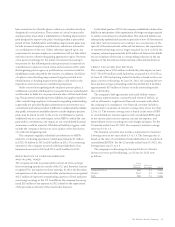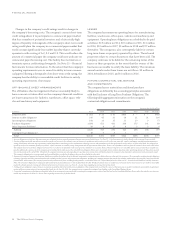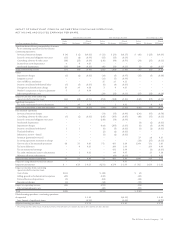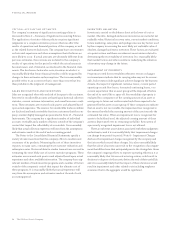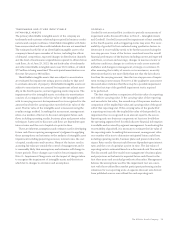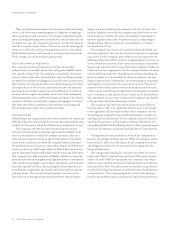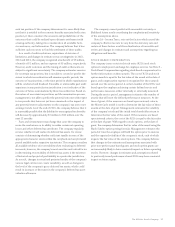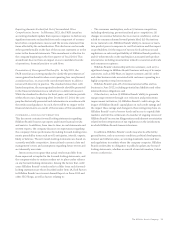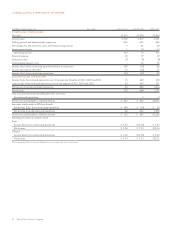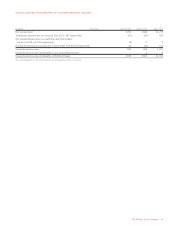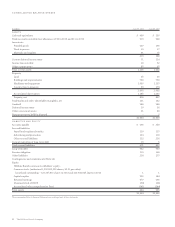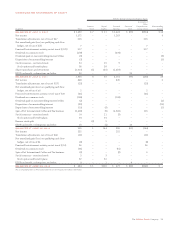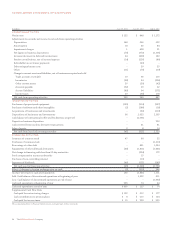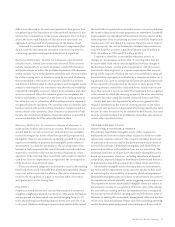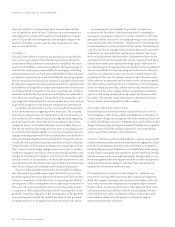Sara Lee 2013 Annual Report Download - page 30
Download and view the complete annual report
Please find page 30 of the 2013 Sara Lee annual report below. You can navigate through the pages in the report by either clicking on the pages listed below, or by using the keyword search tool below to find specific information within the annual report.
DEFINED BENEFIT PENSION PLANS
See Note 16 – Defined Benefit Pension Plans, for information
regarding plan obligations, plan assets and the measurements
of these amounts, as well as the net periodic benefit cost and the
reasons for changes in this cost.
Pension costs and obligations are dependent on assumptions
used in calculating such amounts. These assumptions include
estimates of the present value of projected future pension payments
to all plan participants, taking into consideration the likelihood of
potential future events such as salary increases and demographic
experience. The assumptions used in developing the required esti-
mates include the following key factors: discount rates, expected
return on plan assets, retirement rates and mortality.
In determining the discount rate, the company utilizes a yield
curve based on high-quality fixed-income investments that have a
AA bond rating to discount the expected future benefit payments
to plan participants. In determining the long-term rate of return
on plan assets, the company assumes that the historical long-term
compound growth rate of equity and fixed-income securities will
predict the future returns of similar investments in the plan portfolio.
Investment management and other fees paid out of plan assets
are factored into the determination of asset return assumptions.
Retirement rates are based primarily on actual plan experience,
while standard actuarial tables are used to estimate mortality.
Results that differ from these assumptions are accumulated and
amortized over future periods and, therefore, generally affect the
net periodic benefit cost in future periods.
Net periodic benefit costs for the company’s defined benefit
pension plans related to continuing operations were nil in 2013,
$1 million in 2012 and $13 million in 2011, and the projected benefit
obligation was $1.562 billion at the end of 2013 and $1.680 billion
at the end of 2012. The company currently expects its net periodic
benefit cost for 2014 to be approximately $3 million of income. The
year-over-year change versus 2013 is primarily due to the recognition
of $6 million of settlement losses in 2013 which related to a Canadian
plan, an increase in interest expense resulting from a higher discount
rate and a decrease in expected return on assets. The decrease in
expected return on assets results from lower plan assets at the end
of 2013 due to benefit payments partially offset by a decrease in
the amortization related to actuarial gains/losses.
The following information illustrates the sensitivity of the net
periodic benefit cost and projected benefit obligation to a change
in the discount rate and return on plan assets. Amounts relating to
foreign plans are translated at the spot rate at the close of 2013.
The sensitivities reflect the impact of changing one assumption
at a time and are specific to base conditions at the end of 2013.
It should be noted that economic factors and conditions often
affect multiple assumptions simultaneously and that the effects
of changes in assumptions are not necessarily linear.
Increase/(Decrease) in
2013
2014 Projected
Net Periodic Benefit
Assumption Change Benefit Cost Obligation
Discount rate 1% increase $÷(1) $(187)
1% decrease 6 213
Asset return 1% increase (14) –
1% decrease 14 –
The company’s defined benefit pension plans had a net
unamortized actuarial loss of $228 million in 2013 and $263 mil-
lion in 2012. The unamortized actuarial loss is reported in the
Accumulated other comprehensive loss line of the Consolidated
Balance Sheet. The decrease in the unamortized net actuarial
loss in 2013 was primarily due to a net actuarial gain in 2013
resulting from a decrease in plan liabilities due to the increase in
the weighted average discount rate partially offset by decline in
actual asset performances.
As indicated above, changes in the bond yields, expected
future returns on assets, and other assumptions can have a material
impact upon the funded status and the net periodic benefit cost of
defined benefit pension plans. It is reasonably likely that changes
in these external factors will result in changes to the assumptions
used by the company to measure plan obligations and net periodic
benefit cost in future periods.
ISSUED BUT NOT YET EFFECTIVE
ACCOUNTING STANDARDS
Following is a discussion of recently issued accounting standards
that the company will be required to adopt in a future period.
Offsetting Assets and Liabilities In December 2011, the FASB
issued an amendment on disclosures about offsetting assets and
liabilities. The amendment requires additional disclosures showing
the effect or potential effect of netting arrangements on an entity’s
financial position, including the effect or potential effect of rights of
set-off associated with certain financial instruments and derivative
instruments. The amendment is retroactively effective for the
company beginning in the first quarter of fiscal 2014. This standard
will only impact the company’s disclosures in the Financial Instruments
note to the financial statements and will not have an impact on our
consolidated results of operations, financial position or cash flows.
28 The Hillshire Brands Company
FINANCIAL REVIEW


